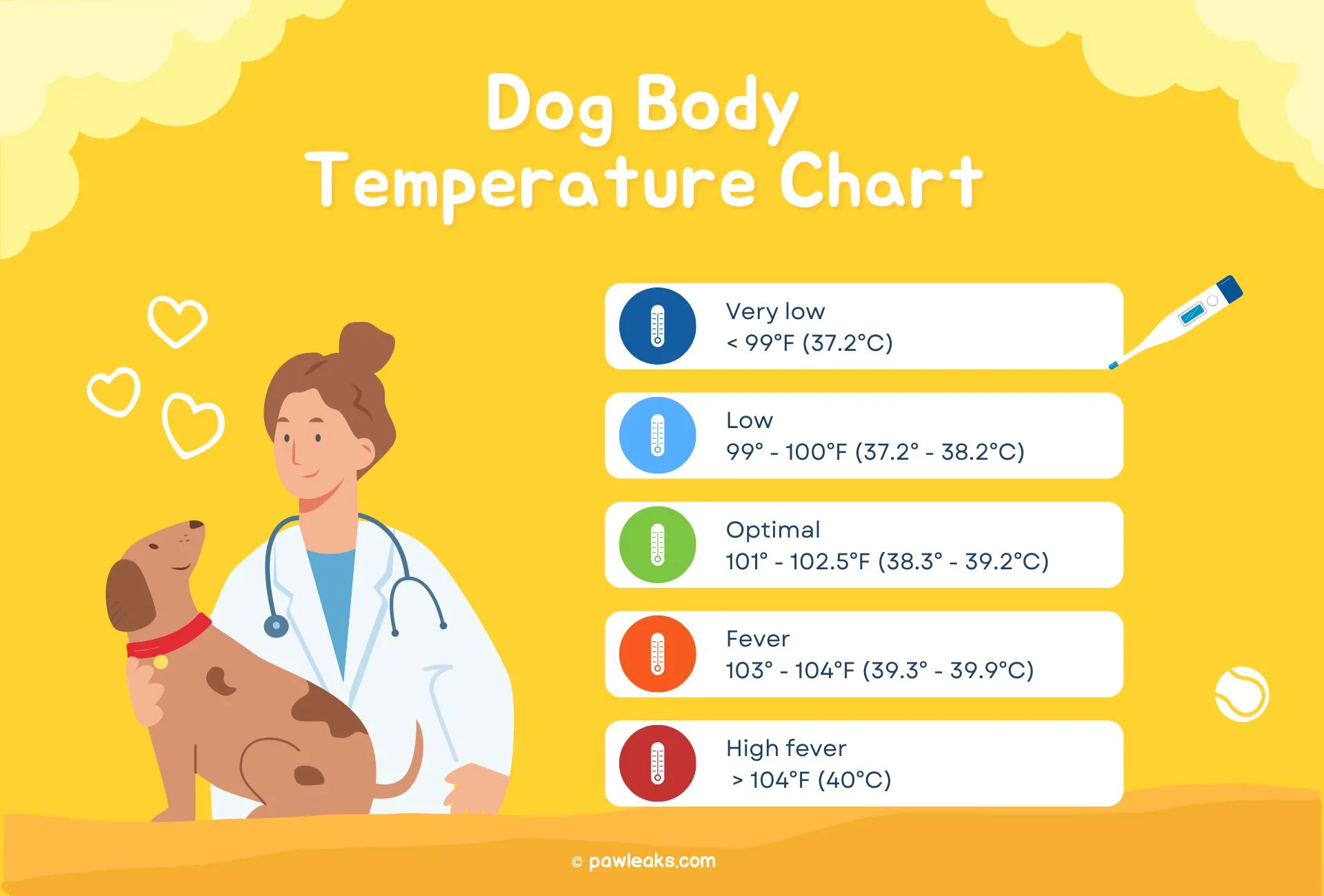If you’ve ever had to take your dog’s body temperature, you’ve probably been confronted with the question of what’s normal vs what isn’t.
Many people don’t even know how to take their dog’s temperature and it’s essential to do it right and then put things into context.
After all, dogs have a higher baseline temperature compared to humans.
I’m not going to bog you down by dragging on about the specific symptoms or causes, others have done that.
For those of you who are interested in the signs or causes, I’ve linked appropriate resources below in my rapid-fire FAQ.
Instead, let’s dive into what specific temperatures tell you about your dog’s health and when you should act.

Dog Temperature Chart
A dog temperature chart can help with evaluating when your dog is too cold or when your dog is running a fever which might require a vet visit if the temperature is above 103°F (39.3°C).

The generally agreed-on optimal temperature is 101-102.5°F (38.3°C-39.2°C) and if your dog moves outside this range, a vet visit might be necessary.
There are some things you can do at home to cool your dog down or warm them up, but your options are limited.
First of all, make sure you’re measuring your dog’s temperature right.
Secondly, check into which category your dog’s body temperature falls.
Is your dog too cold?
Give your vet a call and tell them your dog’s temperature to be sure and in the meanwhile, try to warm him up.
If your dog’s temperature is 100°F (38.2°C) you might be able to get him inside quickly, dry him off, provide a blanket, and keep them hydrated and responsive.
This article on whether or not dogs get cold might help with knowing when it’s okay to go out with your dog and when you need dog boots, a coat, or altogether avoid going out.
Is your dog having a fever?
As soon as your dog moves outside the recommended range of 103°F (39.3°C), you should consult your vet.
Again, at home, you might be able to cool them off with water and a damp cloth, or even a cooling vest until the temperature drops within the optimal range again.
If your dog is going above 104°F (40°C), you need to act and visit the vet.
Dog body temperatures above 106°F can be life-threatening and require an emergency vet visit.
If unsure, it’s always best to check in with your vet.
What Is The Normal Temperature For a Dog?
A normal temperature for dogs is 101-102.5°F (38.3°C-39.2°C) and as soon as your dog goes outside this range, you may need to consult your vet.
Monitor your dog’s behavior, look out for other signs that your dog is not healthy and don’t hesitate to consult your vet, even if you’re unsure about your readings at home.
While dogs have a slightly higher range for what’s normal compared to humans, they still do have quite the narrow range after which it gets concerning rather quickly.
If you’re going beyond 104°F (40°C), you’re not far from the potentially life-threatening territory.
FAQ
Here are a couple of common questions dog owners have related to their dog’s body temperature.
All questions are just answered in a short and concise way. I’ve linked a couple of articles if you want to dive deeper into any individual question.
How To Take a Dog’s Temperature
Choose between the rectal or digital aural technique (the latter is often mentioned by experts as not accurate for dogs though).
Rectal thermometers need to be lubricated and inserted a couple of inches (not too deep) into your dog’s bottom. Hold steady and pull out gently. Electronic ones beep and are often preferred.
Digital ones just need to be calibrated and inserted into the ear. May be difficult if the ear is infected.
Read more here.
How To Tell if a Dog Has a Fever Without Thermometer
If you don’t have a thermometer to take your dog’s temperature, look out for fever symptoms.
Check their ears, nose, and gums for temperature, discharge, and color.
Can I Treat My Dog’s Fever at Home?
To cool your dog down, you can use a cool area, damp washcloth, cold water, as well as a cooling vest.
If the temperature stays above 103°F or even goes up, visit your vet.
Human medicine is almost never recommended and can be fatal. Ask your vet if unsure.
How To Comfort a Dog With a Fever
Besides helping your dog cool down, you should closely monitor him, and can gently pet and stay with your dog. If they’re sick and seek distance, provide them with a safe space.
Dog Low Temperature and Lethargic
If your dog has a low temperature (100°F or below) and is lethargic, you may need to contact your vet due to hypothermia.
Regardless of the temperature, keep a close eye on your dog if you feel like something is off and monitor the changes in temperature.
Sudden drops and/or rises are concerning and should be further investigated as they can point toward another serious medical issue.
Never hesitate to call your vet with a high fever or the fear that your dog might suffer from hypothermia.
Disclaimer: This blog post does not substitute veterinary attention and does not intend to do so. I am not a veterinarian or pet nutritionist. If your dog shows any sign of illness, call your vet.